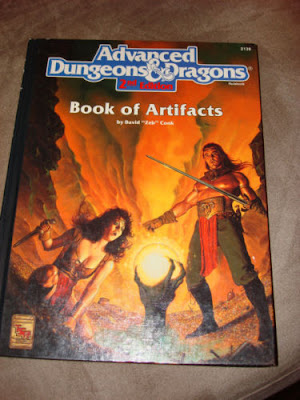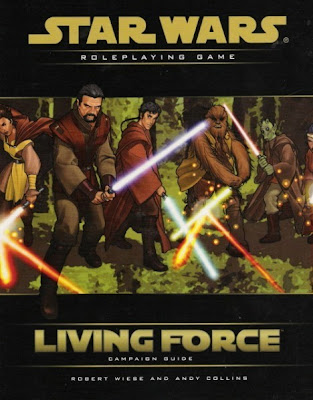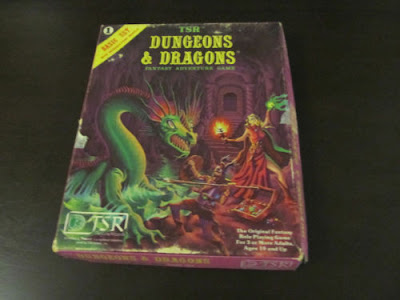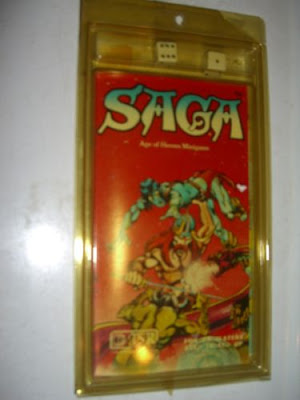When I started reading through the 1981 Moldvay Basic rules I really didn't expect that I would find anything new or exciting to me, especially considering how many times I have looked things up in that book just for the sake of comparing it to something in AD&D, OD&D or Holmes. I assumed what I was going to find was a rules-lite version of AD&D, the "Kiddie-D&D" I had always been biased against since I was a kid myself. I am delighted to say I could not have been more wrong. I have stated on a number of occasions that I started out with Holmes Basic, and it is, more or less, just a re-edit of OD&D, less confusing than OD&D, but not by much and with a few funky house rules Holmes threw in there of his own, that's cool. AD&D was just OD&D all house ruled to hell for E. Gary Gygax's Greyhawk campaign and then declared official TSR, tournament style, never house rule this D&D again, D&D anyway*, right? That and a way to separate it from Dave Arneson's contribution to the hobby in a legal, financial way; or so I have heard.
Anyway, on to my observations about the red book. Right from the get go I could see that this was a different beast than Holmes, it was not simply a restatement of OD&D rules, but an evolution of them; sure they were clearly descended from their immediate ancestor, but they were a new creature, sleeker and more graceful than the one that had come before. I am currently so enamored of Moldvay's rules set that I am seeking out a Mentzer Basic set too, just so I can check it out and make that comparison too.
I was specifically asked by a blog reader to break this analysis of Moldvay down into easily digestible parts, so I will try to not cover too much in this post. I will also attempt to NOT simply compare Moldvay too much to it's immediate predecessor, Holmes Basic, or to 1st edition AD&D, which I am much more familiar with, but I can't promise anything simply because sometimes the only, or at least the easiest way to illustrate is through comparison. I should also mention that this blog post has been a beast to write, I have written and rewritten several sections, switched parts around and, in general, done more work on this post than any other blog post I have ever written; usually I just put out my thoughts as they come to me, do a quick fact check if necessary, look for obvious spelling or grammar errors and send the post on out. This one seemed like more of a special occasion post. I took notes for this one.
On to character generation then. It's totally old school; 3d6 in order (Str, Int, Wis, Dex, Con, Cha) with a slight ability to modify based on what class you choose, you can drop an ability score by 2 points to raise your prime requisite by 1, but you can't drop anything below a 9 and Dexterity, Constitution and Charisma may not be lowered at all, but depending on class Dexterity may be raised. Ability scores are way less fiddly than in AD&D, there is almost a universal stat modifier like in 3e. Except for Humans race equals class, another old school concept that's been gone since the AD&D 1st edition days from my world view, but there it is. I think that may be the biggest hurdle for more modern gamers to accept, and this includes 1st edition AD&D players**.
The classes available are Fighter, Cleric, Magic-User, Thief, Dwarf, Elf & Halfling; a short and simple list. It's the same list, with a slight change in terminology, as the one in Holmes Basic, but way shorter than the list in AD&D. It also doesn't lead us to believe that this is the gateway to AD&D, this version of the Basic book comes right out and tells us that there is an Expert book coming (Spoiler Alert: I looked in the Expert book and it said there was a Companion book coming too), it doesn't ever imply that we should be moving on to AD&D.
So, you rolled your Abilities picked your class, modified if you wanted to or it was possible, now you roll your Hit Points. The bad news here is that if you are used to AD&D your Hit Die shrunk. A Fighter or a Dwarf get a D8, a Cleric, an Elf or a Halfling get a D6 and the Magic-User and Thief get the D4. I kind of felt bad for my players so I let them roll against me for starting Hit Points, that is to say, we both rolled the appropriate die and kept the higher result. Hit Points are still modified by Constitution and there isn't any of AD&D's preferential treatment given to Fighters, so you could possibly have a 7 HP 1st level Magic-User or Thief.
Next we pick Alignment, there are only three to choose from which is actually a step backwards from Holmes Basic, which had five, but really the whole nine Alignment spectrum was there, just not filled in and defined; anyway, Lawful, which is more or less "Good" or allied to civilization, Chaotic is the opposite of Lawful, generally considered Evil, uncivilized, and selfish. Neutral falls in between the other two, either as unintelligent, and therefore unaligned in anyway, or actively preserving some balance between Law and Chaos, or just kind of libertarian and trying to survive.
Anyway, the thing that struck me right away about the classes was that they were both weaker and slightly stronger than their AD&D counterparts; what I mean by this is that AD&D kind of institutionalized the first iteration that all Player Characters were Heroes, not just average Joe's trying to better their existence through adventuring, AD&D gives you a whole bunch of different character creation methods, but the most common/popular one is probably 4d6 rearrange to taste; that's your first character build right there. AD&D is the first D&D where every player can sit down before the game and discuss what character they are going to play before character generation, that doesn't happen in Moldvay, in Moldvay, as in Holmes and in OD&D, you play the character you roll, it's actually kind of liberating. I had forgotten how much I liked that, much in the same way that I had forgotten how much I liked playing without miniatures when I quit playing 3e.
Now, that, and the fact that they get a smaller Hit Die type than AD&D, shows how they are weaker, so how are they stronger? First, they get an average higher amount of starting money than their AD&D counterparts because every character gets 3d6x10 starting gold; everyone except for Fighters makes out better, and the lower cost of better Armor even helps them out with better AC. They were going to get an AC boost anyway because there are only 9 ACs instead of 10. The thing I think makes Player Characters clearly tougher than their AD&D brethren though is the Morale rules in combat, two Morale checks in every combat encounter means that every encounter is not necessarily a slaughter, especially against the weaker low Hit Die Monsters like Goblins. Sure, when I played this past weekend the four Goblins the party encountered fought to the death, and killed the party's Magic-User in the process, but it was just bad luck there.
Every class has some clearly listed restrictions and special abilities; I could quibble with some of the restrictions, particularly considering the fact that variable weapon damage is an optional rule, but I won't for now. One thing I noticed today, after I'd already read through this section several times, was that Halflings DO NOT have infravision in B/X D&D, I went back and looked it up in Holmes and saw no mention of it there either, so EGG apparently decided in the AD&D PH that all Halflings got infravision, in the AD&D MM only Stouts have it and there is no mention in any book that I have before then; I mention this as a case in point of how hard this project has been, to read through rules text that greatly resembles rules text that you are very familiar with looking for the differences.
Of all the classes and racial classes, the one that I think gets hosed is the Thief. They get the d4 for a Hit Die type, no Dexterity adjustments for their Thief skills and their Thief skills are generally worse than they are for a first level Thief in AD&D. In a statistical anomaly, they are actually worse at finding traps than any other characters, despite it actually being one of their class specialties; a first level B/X Thief can find a trap 10% of the time, any character searching for a trap has a 1 in 6 chance or roughly 16.6% of the time, a Dwarf under the right circumstances doubles that to 2 in 6 or 33.3% of the time. Similarly, Halflings can hide in shadows better, 2 in 6 or 33.3% anywhere, 90% outdoors vs. the Thief's 10% chance at 1st level.
Having rolled our Abilities and chosen a Class then, possibly, adjusted them, picked an Alignment, and rolled for starting money, we move on to buying equipment. Fewer choices, quicker to play. There are literally 40 items on the entire list, I could type the entire thing here, with the prices in about a minute. 3 types of armor, Leather, Chain and Plate. 3 types of sword, Short Sword, Sword (normal) and Two-Handed Sword, I might have named them differently, but I am cool with the choices. Variable weapon damage is an optional rule, although I'd recommend it's use. Crossbows are far less screwed than in AD&D, they only get to fire every other round, but at least it makes more sense given the shorter rounds (10 seconds vs AD&D's 1 minute) and they aren't penalized on damage like in AD&D; that was one of the things that always bugged me about AD&D crossbows are vicious, deadly killers in the real medieval period in AD&D they are just a poor choice of ranged weapon.
Right after the equipment page is a page with Languages, Inheritance, "Hopeless Characters" and the run through of Character Generation. Languages are just a list of suggested languages for all of those characters that rolled a high enough Intelligence score to know any additional languages (13+). There are 20 of them listed so it could be easy to make it a random pick if you were indecisive or didn't care. Inheritance is a rule for inheriting the possessions of your previous character. The only place I have seen a similar rule before was in Hackmaster. This rule curiously applies to the player and is once only per player, so, presumably most older gamers that have played B/X are screwed, they probably used this rule back when they were 12 years old so they could keep their cool items from the Monty-Haul days. There is a 10% inheritance tax applied though. "Hopeless Characters" are a little more loosely defined in Moldvay than they are in AD&D or later editions, a Hopeless Character here is "below average in every ability" or has "more than one very low (3-6) ability score" in which case the DM may declare the character hopeless and allow the player to roll up a new one. The run through of Character Generation is cool for a couple of reasons. First, it is concise and easy to follow. Second, it assumes a girl will be playing D&D; I have rarely been part of a D&D group that didn't have some female players, and most of my players are women these days. I guess I missed the part where D&D was supposed to be girl repellant.
There are a few pages of spells listed after character creation and equipment, I suppose now would be a good time to mention the two things about spell casters that are different than AD&D. First, Clerics don't get a spell at first level, I thought this would be a huge weakness in play for the party but it really wasn't. Second, Magic-Users and Elves get to choose their spell, one first level spell, for their spell book, that's it. AD&D Magic-Users get them assigned semi-randomly, but they get four starting spells, Read Magic, an Offensive, a Defensive and a Miscellaneous spell for their spell books. At second level, the Magic-User or Elf will get a second first level spell, at third level they will receive a second level spell. Now I shall end for today, but I want to talk about the actual spells some next time.
*Not that anyone ever played it that way, but that was the intention, to get everyone playing by the same "official" set of rules for the purposes of tournaments. That's what old Dragon Magazine articles said anyway. I might not be imagining things if I thought there was a more mercenary motive in pushing the AD&D product line over the D&D product line, but then again I might be too.
**I am aware that, technically speaking, 1st edition AD&D predates Moldvay Basic; the Basic D&D line represents an older lineage of D&D gaming, AD&D was the more "modern" descendant.
Oh, and it was D&D bargain week on EBay-
A much better copy of the Cook Expert Book, my other one the cover fell off of.

The Mentzer Expert Book, I never had this one, so I am looking forward to reading through it too.

AC2- Combat Shield & Mini-Adventure, the 1984 publication date indicates it's a Mentzer era D&D product, is it compatible with B/X? I'll have to check the charts and see. When I bought it I was hoping so.

Grenadier's Dragon Lords Monster Manuscript, this one is pretty much just an AD&D monster manual for Grenadier's Monster Manuscript line of miniatures released in 1986-7; still more monsters with unique stats is always a good thing, eh?

Dwarf with a Torch, not too much to say there, I just usually throw down a minimum bid on any miniature I find that's carrying a torch or lantern or backpack or chest. Hireling types are hard to find.

Four Knights with a bonus Thief and Warrior, I really didn't expect to win these guys on the minimum bid either, but I did, I already had at least two of that Grenadier Thief. The Knights are nice, but kind of scrawny even for old 25mm scale, and the Warrior I'll need to strip and repaint, anyone recognize the company?

The High Level Campaign Book I grabbed because it was cheap and I never even saw it before, much less read it.

Ditto the Book of Artifacts, same seller, I must have been asleep for that part of 2nd edition AD&D's life cycle.






























